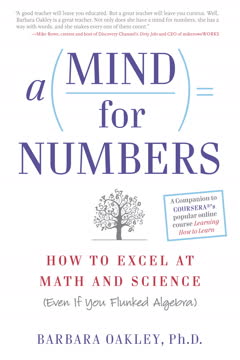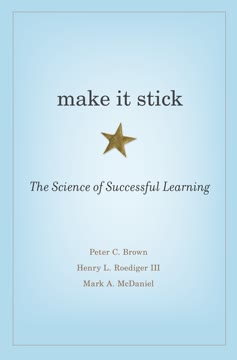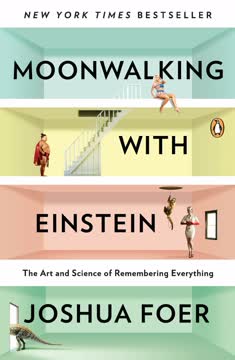가지 주요 요점
1. 기억 챔피언들은 고대 기술을 활용하여 비범한 성과를 이룬다
"아드 헤레니움에서 소개된 기술들은 고대 세계에서 널리 사용되었다."
고대의 지혜, 현대의 적용. 기억 챔피언들은 고대 그리스와 로마로 거슬러 올라가는 기술, 특히 '장소의 방법' 또는 '기억의 궁전' 기법을 사용한다. 이 방법들은 한때 연설가와 학자들에 의해 사용되었으며, 현대의 기억 대회에 맞게 조정되었다.
비범한 결과. 이러한 기술을 사용하여 기억 선수들은 다음과 같은 불가능해 보이는 성과를 이룰 수 있다:
- 섞인 카드 덱의 순서를 1분 이내에 암기하기
- 단 한 번의 시청으로 수백 개의 무작위 숫자를 기억하기
- 긴 시가나 연설을 정확히 암송하기
고대와 현대 모두에서 이러한 기술의 성공은 적절히 훈련되고 활용될 때 인간 기억의 잠재력이 얼마나 큰지를 보여준다.
2. '기억의 궁전' 기법은 공간 기억을 활용하여 회상을 향상시킨다
"아이디어는 마음의 눈에 공간을 만들어, 잘 알고 쉽게 시각화할 수 있는 장소를 만든 다음, 기억하고 싶은 것을 나타내는 이미지를 그 상상된 장소에 채우는 것이다."
공간 기억을 기반으로 한 구조. 기억의 궁전 기법은 우리가 공간 정보를 기억하는 본능적인 능력을 활용한다. 특정 정보를 친숙한 공간의 특정 위치와 연관시킴으로써 회상을 위한 정신 지도를 만든다.
생생한 이미지로 지속적인 인상 남기기. 효과적인 기억의 궁전의 주요 요소는 다음과 같다:
- 친숙한 장소 사용하기 (예: 어린 시절 집, 자주 걷는 경로)
- 정보를 나타내기 위해 생생하고 종종 기괴하거나 과장된 이미지를 만들기
- 시각화 과정에서 여러 감각을 활용하기
- 기억의 궁전을 정기적으로 방문하고 '유지'하기
이 기법은 추상적인 정보를 구체적이고 기억하기 쉬운 이미지로 변환하여 대량의 데이터를 빠르고 정확하게 회상할 수 있는 능력을 크게 향상시킨다.
3. 의도적인 연습이 전문가 수준의 기억을 개발하는 열쇠이다
"우리가 전문성이라고 부르는 것은 사실 '관련 분야에서 수년간의 경험을 통해 습득한 방대한 지식, 패턴 기반 검색 및 계획 메커니즘'일 뿐이다."
노력을 통한 전문성. 저자의 평균적인 기억에서 미국 기억 챔피언으로의 여정은 뛰어난 기억 기술이 타고난 것이 아니라 길러지는 것임을 보여준다. 이는 체스에서 음악에 이르기까지 다양한 분야의 전문성에 대한 연구와 일치한다.
의도적인 연습의 구성 요소:
- 집중적이고 목표 지향적인 훈련
- 즉각적인 피드백과 오류 수정
- 편안한 영역을 넘어서는 도전
- 일관된 장기적 헌신
기억 선수들과 다른 전문가들의 성공은 자연적인 재능이 뛰어난 성과의 주요 원동력이라는 개념에 도전한다. 대신, 비범한 기술을 개발하는 데 있어 헌신적이고 전략적인 연습의 힘을 강조한다.
4. 외부 기억 도구에 대한 의존은 우리의 자연 기억 능력을 감소시켰다
"오늘날 우리는 빠르고 널리 읽는 것을 중시하며, 이는 우리의 독서와 책에서 얻고자 하는 것에 일종의 피상성을 낳는다."
기술의 양날의 검. 현대 기술은 정보에 대한 접근을 크게 확장했지만, 내부 기억에 대한 의존도를 줄였다. 이러한 변화는 깊이 있는 학습과 기억 유지 능력을 감소시켰을 가능성이 있다.
외부화된 기억의 결과:
- 기본 정보(예: 전화번호, 길 안내)를 회상하는 능력 감소
- 학습한 자료에 대한 참여도 감소
- 능동적인 암기와 관련된 인지적 이점의 잠재적 손실
저자는 우리의 기억을 외부 장치에 아웃소싱함으로써 필수적인 인지 기술과 정보 간의 의미 있는 연결을 형성하는 능력을 잃고 있을 수 있다고 주장한다.
5. 기억을 향상시키는 것은 전반적인 인지 기능과 삶의 질을 개선한다
"기억은 유연성, 힘, 지구력을 기르기 위해 가르치는 것과 정확히 같은 방식으로 기술로 가르쳐져야 한다."
인지적 피트니스로서의 기억. 기억 기술을 개발하는 것은 단순히 사실을 회상하는 것이 아니라 전반적인 정신적 예리함과 인지적 유연성을 향상시키는 것이다. 향상된 기억은 다음과 같은 결과를 가져올 수 있다:
- 문제 해결 능력 향상
- 창의성과 혁신 증대
- 다양한 분야에서의 학습 능력 증가
실제적인 이점. 기억 기술을 강화하는 것은 삶의 여러 측면에 긍정적인 영향을 미칠 수 있다:
- 학업 및 직업 성과
- 사회적 상호작용(예: 이름과 얼굴 기억하기)
- 개인 성장 및 평생 학습
- 인지 저하에 대한 잠재적 보호
기억을 개발해야 할 기술로 간주함으로써 개인은 전반적인 삶의 질과 정신적 성과를 향상시키는 더 넓은 인지적 향상을 이끌어낼 수 있다.
6. 기억의 기술은 한때 교육과 지적 추구의 중심이었다
"한때, 생각과 관련된 것은 기억하는 것 외에는 아무것도 없었다."
역사적 중요성. 인쇄술 이전의 문화에서 기억은 지식을 보존하고 전달하는 데 필수적이었다. 기억의 기술은 고전 및 중세 교육의 기본적인 부분으로, 사람들이 배우고 사고하는 방식을 형성했다.
교육적 초점의 변화:
- 암기에서 분석과 창의성으로
- 외부 정보 출처에 대한 강조
- 현대 교육에서 기계적 암기의 역할에 대한 논의
저자는 순수한 암기에서 벗어난 변화가 이점을 가져왔지만, 그 과정에서 귀중한 인지 도구를 잃었을 수 있다고 제안한다. 기억 기술을 교육에 재통합하는 것은 학습 결과와 인지 발달을 향상시킬 수 있다.
7. 서번트 증후군은 인간 기억 잠재력에 대한 우리의 이해에 도전한다
"트레퍼트가 말하듯, '모든 뇌 속에 숨겨진 작은 레인 맨이 있을 수 있다.'"
예상치 못한 개인의 비범한 능력. 서번트 증후군은 발달 장애가 있는 개인이 특정 분야에서 비범한 기술을 보이는 현상으로, 종종 기억을 포함하여 인간의 인지 잠재력에 대한 우리의 이해에 도전한다.
서번트 연구의 통찰:
- 모든 뇌에 잠재적인 능력이 있을 가능성
- 기술을 여는 뇌 손상이나 비정상적 발달의 역할
- 서번트에서도 집중된 주의와 연습의 중요성
서번트 능력은 드물고 종종 상당한 도전과 동반되지만, 인간의 뇌가 비범한 기억과 인지 기술에 대한 잠재력을 가지고 있을 수 있음을 시사한다. 이 잠재력은 특정 훈련이나 특정 조건에서 접근 가능할 수 있다.
8. 기억 기술은 실제 학습과 직업적 성공에 적용될 수 있다
"매튜스는 기억의 기술이 그의 학생들이 읽기와 수학에서 평균 이하인 동네를 벗어나는 티켓이 될 것이라고 믿는다."
실용적인 응용. 기억 기술은 단순한 대회용이 아니라 교육과 직업 개발을 위한 강력한 도구가 될 수 있다. 예를 들어:
- 학생들이 기억의 궁전을 사용하여 학문적 과목을 마스터하기
- 전문가들이 기술을 사용하여 고객 정보를 기억하거나 노트 없이 연설하기
- 언어 학습자들이 기억 장치를 사용하여 어휘를 더 빠르게 습득하기
더 넓은 인지적 이점. 단순한 회상을 넘어, 기억 기술은 다음을 향상시킬 수 있다:
- 비판적 사고 및 분석 능력
- 창의성과 문제 해결 능력
- 학습에 대한 자신감과 자기 효능감
기억 기술을 교육 및 직업 훈련에 통합함으로써 개인은 학습의 도전을 극복하고 다양한 분야에서 더 큰 성공을 거둘 수 있다.
9. 기억의 미래: 기술과 인지 향상의 균형
"내 손끝에 잃어버린 모든 지식이 있다면, 그것은 무엇을 의미할까?"
기술적 증강. 웨어러블 장치와 뇌-컴퓨터 인터페이스와 같은 기술의 발전은 우리의 기억 능력을 생물학적 한계를 넘어 확장할 것을 약속한다.
미래의 잠재적 발전:
- 외부 기억과 내부 기억의 원활한 통합
- 인공지능 지원을 통한 향상된 회상
- 정보 저장 및 검색을 위한 직접적인 신경 인터페이스
윤리적 및 철학적 고려사항:
- 증강된 기억 시대의 개인 정체성의 본질
- 포괄적인 기억 기록에 대한 프라이버시 문제
- 인간 심리와 사회에서 망각의 가치
기술적으로 향상된 기억의 미래로 나아가면서, 확장된 인지 능력의 이점을 필수적인 인간 경험과 가치의 보존과 균형을 이루는 것이 중요하다. 도전은 우리의 자연적인 인지 능력을 대체하기보다는 보완하는 기술을 활용하는 데 있다.
마지막 업데이트 날짜:
FAQ
What's Moonwalking with Einstein about?
- Memory Techniques Exploration: The book follows Joshua Foer's journey to enhance his memory, leading to his participation in the U.S. Memory Championship. It focuses on memory techniques like the method of loci, or memory palace.
- Personal and Historical Insights: Foer combines his personal experiences with historical anecdotes, such as the story of Simonides of Ceos, who is credited with inventing the memory palace technique.
- Cultural Commentary: The narrative examines how modern technology affects our memory, arguing that reliance on external devices has diminished our natural memory capabilities.
Why should I read Moonwalking with Einstein?
- Engaging Narrative: Foer's writing is both informative and entertaining, making complex memory concepts accessible to a general audience.
- Practical Techniques: The book offers practical memory techniques, like the memory palace method, which can be applied in everyday life to enhance learning and retention.
- Thought-Provoking Themes: It raises questions about the nature of memory and its role in our lives, encouraging readers to reflect on their own memory practices.
What are the key takeaways of Moonwalking with Einstein?
- Memory is Trainable: Foer demonstrates that memory can be improved with practice and the right techniques, transforming from an average memorizer to a champion.
- Memory Palace Technique: The method of loci is a central theme, involving visualizing a familiar place and associating items to remember with specific locations.
- Cultural Shift in Memory: The book discusses how writing and technology have changed our relationship with memory, leading to a decline in natural memory abilities.
What are the best quotes from Moonwalking with Einstein and what do they mean?
- “Memory is the mother of all wisdom.”: This quote highlights the foundational role of memory in acquiring knowledge and wisdom.
- “The brain is like a muscle.”: This analogy suggests that mental exercises can enhance memory, similar to how physical exercise strengthens muscles.
- “The art of memory is the art of attention.”: It emphasizes that effective memorization requires focus and mindfulness.
What memory techniques does Joshua Foer discuss in Moonwalking with Einstein?
- Method of Loci: This technique involves visualizing a familiar space and placing items to remember along a mental journey through that space.
- Chunking: Foer explains how chunking information into manageable units can improve memory retention by grouping related items together.
- Elaborative Encoding: Transforming mundane information into vivid, memorable images by engaging multiple senses and creating emotional connections.
How does technology affect our memory, according to Moonwalking with Einstein?
- Reliance on External Aids: Foer argues that modern technology, like smartphones, has led to a decline in our natural memory abilities.
- Cultural Shift: The shift from oral to written culture has changed our relationship with memory, making us less reliant on our own memories.
- Memory as Identity: Memory is integral to our sense of self, and its erosion due to technology raises questions about our understanding of ourselves.
What is the memory palace technique mentioned in Moonwalking with Einstein?
- Visualizing Locations: The technique involves associating information with specific locations in a familiar place for easier recall.
- Creating Vivid Images: By placing memorable images in these locations, one can navigate through the palace to retrieve stored information.
- Historical Roots: This method has been used by orators and scholars for centuries to enhance memory.
How does Foer describe the process of memorizing a deck of cards?
- Using the PAO System: Foer uses the Person-Action-Object system, where each card is represented by a unique image of a person performing an action on an object.
- Memory Palaces for Recall: He places these images in a memory palace, allowing him to visualize the sequence of cards.
- Practice and Speed: Through rigorous practice, he improves his speed and accuracy, eventually breaking the U.S. record for memorizing a deck of cards.
How does Foer’s personal journey reflect the themes of Moonwalking with Einstein?
- Transformation Through Practice: Foer’s journey from an average memorizer to a U.S. Memory Champion exemplifies the theme that memory can be trained and improved.
- Exploration of Identity: His quest to enhance his memory becomes a metaphor for understanding oneself and one’s place in the world.
- Cultural Commentary: Foer critiques modern society's relationship with memory, highlighting the tension between technological reliance and personal memory.
What challenges does Foer face in improving his memory?
- Initial Struggles: He encounters difficulties in mastering memory techniques, particularly when trying to memorize poetry.
- Time and Effort: Training his memory requires significant time and dedication, which can be exhausting.
- Self-Doubt: Foer grapples with self-doubt and the fear of not measuring up to elite memory competitors.
How does Moonwalking with Einstein connect memory to broader cultural themes?
- Memory and Identity: Foer argues that memory is fundamental to our sense of self and cultural identity.
- Historical Context: The narrative situates memory techniques within a historical framework, illustrating their evolution over time.
- Critique of Modernity: The book critiques the impact of technology on memory, suggesting that reliance on external aids has diminished our natural abilities.
What does Joshua Foer ultimately conclude about memory and its importance?
- Memory Shapes Identity: He emphasizes that memory is integral to our sense of self and how we navigate the world.
- Need for Mindfulness: Foer advocates for a mindful approach to memory, encouraging readers to engage with their experiences.
- Resistance to Forgetting: The book calls for embracing the art of memory as a vital human skill in a technology-driven world.
리뷰
문워크와 아인슈타인은 조슈아 포어가 기억 챔피언이 되기 위한 여정을 담고 있으며, 기억의 궁전과 같은 다양한 기법을 탐구한다. 독자들은 포어의 글쓰기 스타일과 기억의 역사 및 잠재력에 대한 통찰력을 높이 평가하며 흥미롭고 유익하다고 느꼈다. 일부는 이 책이 실용적인 응용이 부족하다고 생각했지만, 다른 이들은 그 기법을 시도해보도록 영감을 받았다. 비평가들은 이 책이 역사, 과학, 개인적인 서사를 아우르는 폭넓은 주제를 다루고 있다고 지적했다. 전반적으로 리뷰어들은 이 책이 오락성과 교육성을 잘 결합하고 있다고 평가했지만, 그 지속적인 영향력에 대한 의견은 엇갈렸다.
Similar Books









